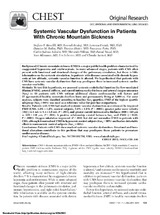Mostrar el registro sencillo del ítem
Systemic vascular dysfunction in patients with chronic mountain sickness
| dc.contributor.author | Rimoldi, Stefano F | |
| dc.contributor.author | Rexhaj, Emrush | |
| dc.contributor.author | Pratali, Lorenza | |
| dc.contributor.author | Bailey, Damian | |
| dc.contributor.author | Hutter, Damian | |
| dc.contributor.author | Faita, Francesco | |
| dc.contributor.author | Salinas Salmón, Carlos E | |
| dc.contributor.author | Villena, Mercedes | |
| dc.contributor.author | Nicod, Pascal | |
| dc.contributor.author | Allemann, Yves | |
| dc.contributor.author | Scherrer, Urs | |
| dc.contributor.author | Sartori, Claudio | |
| dc.date.accessioned | 2016-09-27T16:22:02Z | |
| dc.date.available | 2016-09-27T16:22:02Z | |
| dc.date.issued | 2012-01-01 | |
| dc.identifier.uri | http://repositorio.umsa.bo/xmlui/handle/123456789/8046 | |
| dc.description.abstract | Background: Chronic mountain sickness (CMS) is a major public health problem characterized by exaggerated hypoxemia and erythrocytosis. In more advanced stages, patients with CMS often present with functional and structural changes of the pulmonary circulation, but there is little information on the systemic circulation. In patients with diseases associated with chronic hypoxemia at low altitude, systemic vascular function is altered. We hypothesized that patients with CMS have systemic vascular dysfunction that may predispose them to increased systemic cardiovascular morbidity. Methods: To test this hypothesis, we assessed systemic endothelial function (by flow-mediated dilation [FMD]), arterial stiffness, and carotid intima-media thickness and arterial oxygen saturation (SaO2) in 23 patients with CMS without additional classic cardiovascular risk factors and 27 age-matched healthy mountain dwellers born and permanently living at 3,600 m. For some analyses, subjects were classified according to baseline SaO2 quartiles; FMD of the highest quartile subgroup (SaO2 90%) was used as a reference value for post hoc comparisons. Results: Patients with CMS had marked systemic vascular dysfunction as evidenced by impaired FMD (CMS, 4.6% 1.2%; control subjects, 7.6% 1.9%; P,.0001), greater pulse wave velocity (10.6 2.1 m/s vs 8.4 1.0 m/s, P,.001), and greater carotid intima-media thickness (690 120 mm vs 570 110 mm, P5.001). A positive relationship existed between SaO2 and FMD (r50.62, P,.0001). Oxygen inhalation improved (P,.001) but did not normalize FMD in patients with CMS, although it normalized FMD in hypoxemic control subjects (SaO2,90%) and had no detectable effect in normoxemic control subjects (SaO2 90%). Conclusions: Patients with CMS show marked systemic vascular dysfunction. Structural and functional alterations contribute to this problem that may predispose these patients to premature cardiovascular disease. | es_ES |
| dc.language.iso | en | es_ES |
| dc.publisher | CHEST | es_ES |
| dc.subject | DISFUNCIÓN VASCULAR | es_ES |
| dc.subject | MAL CRÓNICO DE MONTAÑA | es_ES |
| dc.subject | DISFUNCIÓN SISTÉMICA VASCULAR | es_ES |
| dc.title | Systemic vascular dysfunction in patients with chronic mountain sickness | es_ES |
| dc.type | Article | es_ES |

